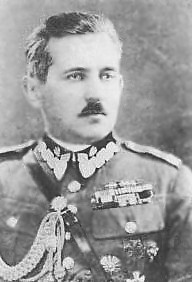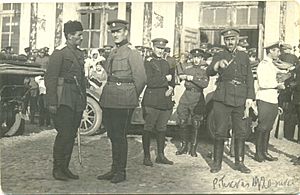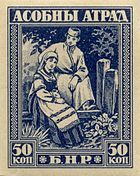Stanisław Bułak-Bałachowicz facts for kids
Quick facts for kids
Stanisław Bułak-Bałachowicz
|
|
|---|---|
 |
|
| President of the Belarusian Provisional Government | |
| In office 12 November 1920 – 28 November 1920 |
|
| Preceded by | Piotra Krečeŭski (in exile) |
| Succeeded by | Piotra Krečeŭski (in exile) |
| Personal details | |
| Born | 10 February 1883 Meyshty, Novoalexandrovsky Uyezd, Kovno Governorate, Russian Empire |
| Died | 10 May 1940 (aged 57) Warsaw, General Government, Nazi Germany |
| Military service | |
| Allegiance | |
| Branch/service | |
| Rank | General |
Stanisław Bułak-Bałachowicz (born 12 November 1883 – died 10 May 1940) was a brave general and military leader. He fought in many important wars. These included World War I, the Russian Civil War, and the Polish-Soviet War. He also fought in the 1939 Invasion of Poland at the start of World War II.
Many people remember him as a hero. He is especially important to the Belarusian opposition and the Belarusian minority in Poland.
Contents
Biography of Stanisław Bułak-Bałachowicz
Early Life and Nicknames
Stanisław Bułak-Bałachowicz was born on February 10, 1883. His birthplace was a small village called Meyshty. This village was in the Russian Empire, in an area that is now Lithuania. He had two brothers and six sisters. His parents worked for a local landlord who was Belarusian.
Later, his father bought a small piece of land near Vilnius. Stanisław went to an agricultural school for four years. After school, he worked as an accountant. In 1904, he became a manager for Count Plater's estates.
Stanisław was known for helping people. He often settled arguments between farmers and their landlord. Because of this, people called him "Daddy" (Bat'ka). He also got another nickname, "Bułak." This word means 'cloud' in the Belarusian language. This nickname became part of his last name.
Fighting in World War I
When World War I began, Bułak-Bałachowicz joined the Imperial Russian Army. He started as an ensign. This was because he came from a noble family. But he quickly showed he was a great leader. He was promoted very fast.
By December 1914, he led a group of Cossack volunteers. He formed them into a cavalry squadron. He fought on the western front, near Warsaw. In 1915, German forces took Warsaw. His unit had to retreat towards Latvia.
In November 1915, he joined a special partisan regiment. This unit fought behind enemy lines near Riga. They were known for their daring actions. People called them "Knights of Death." His unit was very flexible. It had different types of cavalry soldiers. This helped them fight behind enemy lines until 1918.
For his bravery in the German campaign, he received many awards. He earned six Russian decorations. He also received three Crosses of St. George.
The Russian Civil War
In March 1918, Bułak-Bałachowicz was badly wounded in a fight. He was shot in the lung. After he recovered, he joined his brother Józef. Józef was helping to create a Polish cavalry group. This group was later disbanded by the Bolsheviks.
With help from France, a new Polish cavalry unit was formed. Stanisław Bułak-Bałachowicz became its commander. Even Leon Trotsky recognized this new unit. It was planned to become a cavalry division of the Red Army.
Soon, Bułak-Bałachowicz was ordered to stop a peasant uprising. He managed to calm the unrest without fighting. But he feared being arrested by his superiors. So, he and his cavalry unit left the Bolsheviks. They moved to an area held by White Russian and German forces.

At first, he fought against the Reds with the White forces. But he soon had problems with German officials. So, he switched sides again. He disarmed the German units around him. Then, he fought his way through enemy territory to Estonia. There, he helped form general Nikolai Nikolaevich Yudenich's army. His units helped the Estonian Army win battles in the Estonian War of Independence. He was promoted to lieutenant colonel.
In May 1919, Bałachowicz led an "assault group." They surprised and captured the town of Gdov. Later, they entered Pskov. For this success, General Yudenich promoted him to colonel. His soldiers, many of whom were Belarusian, called him "ataman" or "Bat'ko" (father).
Bułak-Bałachowicz became the military leader of Pskov. He worked to help the city recover from the war. He also allowed newspapers to be uncensored. This made some White generals angry. After Pskov was lost again, General Yudenich ordered his arrest. But Bułak-Bałachowicz escaped. He gave his division to his brother Józef. He then formed a new partisan unit with 600 men.
He continued to fight behind Red Army lines. His unit helped White Russian forces in their attacks. They destroyed railway lines, which helped the White forces at first. However, Yudenich's army could not connect with Bułak-Bałachowicz's forces. Their attack eventually failed.
In January 1920, General Yudenich disbanded his army. Bułak-Bałachowicz was arrested by Estonian police. He had a lot of money with him. He gave this money to the soldiers of the disbanded army as their last pay. This made him very popular among them.
Serving the Belarusian Democratic Republic

Since 1918, Bałachowicz had been in touch with leaders of the Belarusian Democratic Republic (BDR). In November 1919, the BDR government agreed to support his unit. On November 14, Stanisław Bułak-Bałachowicz became a Belarusian citizen. He officially joined the service of the Belarusian Democratic Republic.
His unit was renamed the Special Unit of the Belarusian Democratic Republic in the Baltics. They received Belarusian uniforms and a special seal. The unit even issued its own postal stamps. They also fought in some small battles against the Bolsheviks.
The Polish-Bolshevik War
In February 1920, Stanisław Bułak-Bałachowicz offered to join the Polish Army. He wanted to fight against Bolshevist Russia. Józef Piłsudski, the Polish leader, agreed. Bułak-Bałachowicz and about 800 cavalrymen began a long journey. They rode hundreds of kilometers behind enemy lines. They traveled through Latvia to reach Polish-controlled territory. In mid-March, they arrived in Dyneburg. Józef Piłsudski himself greeted them as heroes.
His unit was reformed into the Bułak-Bałachowicz Operational Group. It was made up mostly of Belarusian volunteers. It also included former Red Army soldiers. This group was considered an allied army.
This division was very successful in the Polish-Bolshevik War. They started fighting in June 1920. Bułak-Bałachowicz often broke through enemy lines. On June 30, he captured a village in Belarus. He surprised and defeated a Soviet unit there. On July 3, another enemy unit was completely destroyed.
During the Bolshevik attack on Poland, Bułak-Bałachowicz's group retreated. They acted as a rearguard for the Polish army. During the Battle of Warsaw, his forces counter-attacked. They secured the town of Włodawa. They defended it successfully against stronger enemy forces. Stanisław Bułak-Bałachowicz used active defense tactics. He stopped enemy attacks before they could even start.
In September 1920, his unit chased the retreating Red Army. They captured Kamien Koszyrski, taking over 1000 prisoners. During the Battle of the Niemen River, his unit stopped the enemy from forming a defense line. On September 26, his forces captured Pinsk. This city was a very important railway hub. It was planned as the last stand for Bolshevik forces in the area.
Failed Uprising in Belarus
In October, Stanisław Bułak-Bałachowicz's forces were in Pinsk. They received supplies and many former Red Army soldiers. These soldiers had been prisoners of war and volunteered to fight against the Bolsheviks. His unit was supposed to fight again in November. But on October 12, a cease fire was signed.
Bułak-Bałachowicz was given a choice. He could either stay in Poland or continue fighting the Reds on his own. He chose to keep fighting. Many other anti-Bolshevik units fighting with Poland made the same choice.
On November 2, 1920, his units were renamed the Russian People's Volunteer Army. They moved into areas that Poland was leaving. Three days later, his forces entered Russian-held Belarus. They started an attack towards Homel. General Bułak-Bałachowicz hoped for a Belarusian uprising against the Bolsheviks. His forces had some early success. They captured Homel and Rechytsa.
On November 10, 1920, Bułak-Bałachowicz entered Mozyr. There, he declared the independence of the Belarusian Democratic Republic. He announced himself as the head of state. He also started forming a new Belarusian National Army. On November 16, he created the Belarusian Provisional Government. However, the uprising did not get much support. The Belarusian people were tired from years of war. The Red Army eventually gained the upper hand.
On November 18, 1920, Bałachowicz left Mozyr. He began to retreat towards the Polish border. His troops fought their way to Poland. They caused heavy losses to the Russians. On November 28, the last of his units crossed into Poland. They were then held in camps.
The Soviet Russian government demanded that Bułak-Bałachowicz be handed over. They wanted to try him for treason. The Riga Peace Conference was even stopped for several days because of these demands. But the Polish government refused. They said Bułak-Bałachowicz had been a Polish citizen since 1918.
Life Between the Wars
After the Riga Peace Treaty, Bułak-Bałachowicz and his men were released. The general left the army and lived in Warsaw. He became active in groups for war veterans. He also wrote two books about a possible future war with Germany. These books were titled "Will There Be War or Will There Be None" (1931) and "Down With Hitler or Long live Hitler?" (1933). From 1936 to 1939, he advised Franco's forces in the Spanish Civil War.
Fighting in World War II
During the Polish Defensive War in 1939, Stanisław Bułak-Bałachowicz volunteered for the Polish army. He created a Volunteer Group to help defend Warsaw. This unit had about 1750 infantrymen and 250 cavalrymen. They were not well-equipped.
The unit fought on the southern side of Warsaw's defense. They used fast attacks on the enemy's rear. On September 12, 1939, they fought for the first time. They surprised the German defenders. They recaptured the Służew borough and the Służewiec horse track. Later, the cavalry attacked German infantry in Natolin. On September 23, the unit moved to northern Warsaw. They planned an attack on German positions. But a cease-fire was signed on September 27.
After Warsaw surrendered, General Bułak-Bałachowicz avoided being captured. He returned to civilian life. He also helped organize the Military Confederation. This was one of the first underground resistance groups in Poland. In early 1940, the Gestapo found him. He was arrested in Warsaw. Stanisław Bułak-Bałachowicz was shot by Gestapo agents on May 10, 1940, in Warsaw.
Many members of the Belarusian minority in Poland see him as a national hero. This is because he resisted Bolshevik forces.
Awards and Honors
- Cross of St. George, 4th class
- Medal of St. George, 4th class
- Cross of Valour (Poland)
- Cross of Valour of the Bułak-Bałachowicza Army
See also
 In Spanish: Stanisław Bułak-Bałachowicz para niños
In Spanish: Stanisław Bułak-Bałachowicz para niños
- List of unsolved murders
- Polish Defensive War

